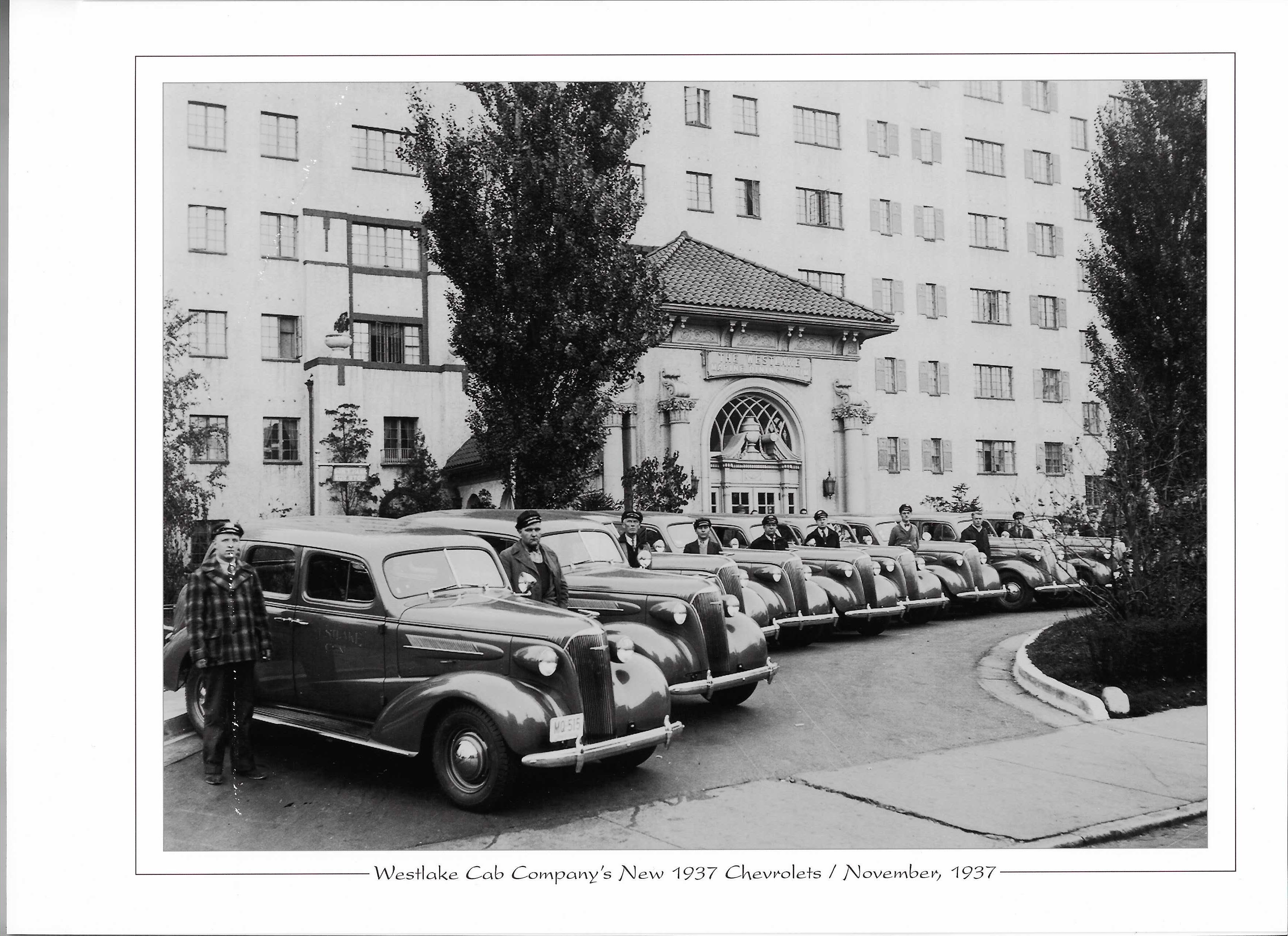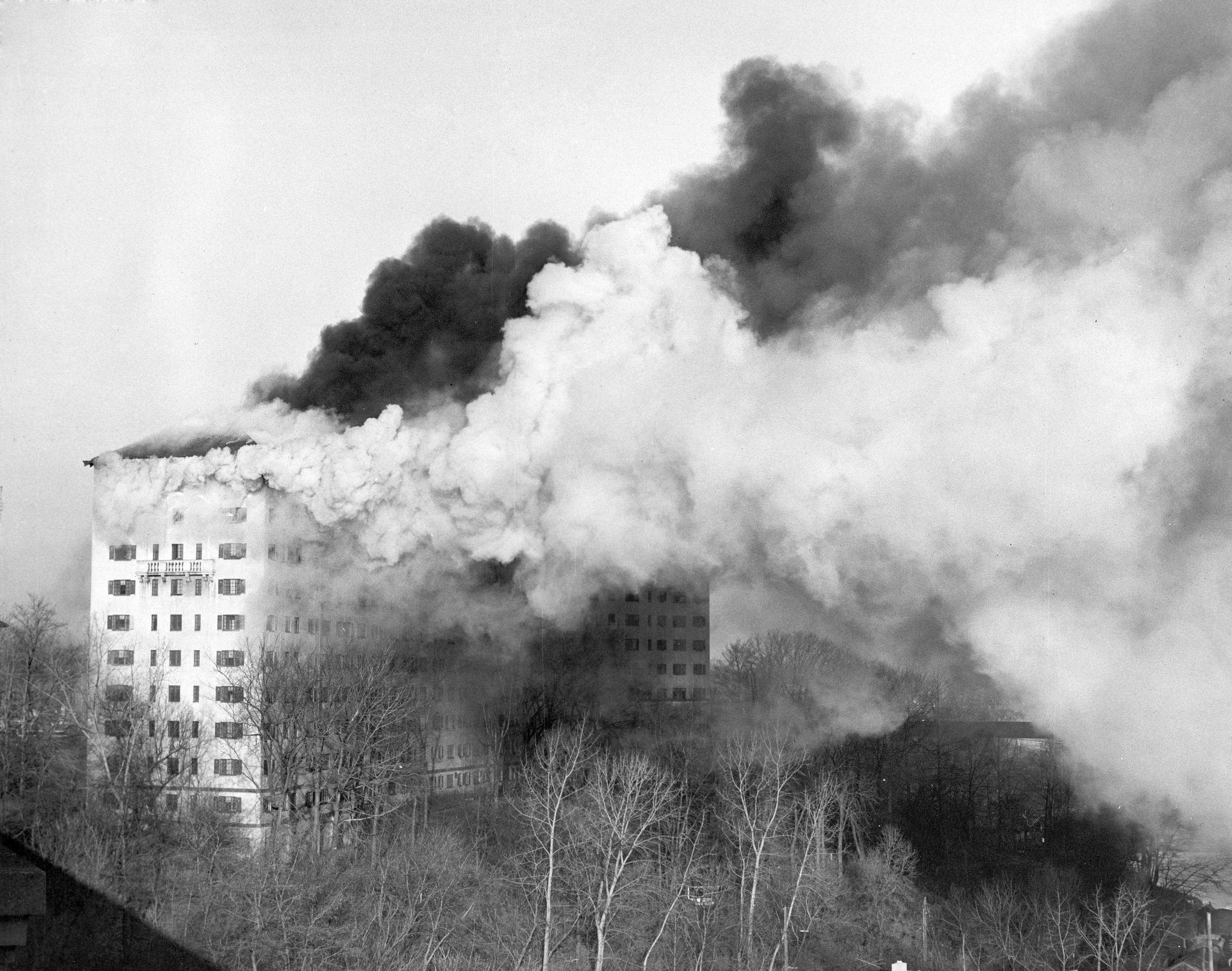The WESTLAKE HOTEL, built in 1925 and dubbed the "pink palace" by locals, was one of the first luxury suburban hotels in the nation. Located at Detroit Ave. and Wooster Road near the mouth of the Rocky River, the Hotel typifies the ROCKY RIVER suburb more than any other single landmark.
The Westlake was not the first building on the site. Since 1816, there has been an inn, tavern, or hotel where the Westlake building is today. The first of these was Wright’s tavern, known far and wide for its unrivaled view of the Lake and as the principal tavern in the area. Wright’s tavern was the site of many township meetings back when Rocky River and LAKEWOOD were part of ROCKPORT TOWNSHIP. When Rufus Wright built the Tavern, there was no bridge over the lower Rocky River; the Tavern could only be accessed from the east by a river ferry or ford. Wright’s Tavern, besides serving as a local meeting place, also filled the role of inn, stagecoach stop, and U.S. post office.
In 1853, Jacob Silverthorne purchased Wright’s Tavern, renamed it the Silverthorne Inn (sometimes spelled Silverthorn with no “e”), and moved his family from BRATENHAL to Rocky River to run it. The Silverthorne soon became known for its delicious chicken dinners. For 66 years, the Silverthorne Inn remained a popular social center until it was torn down to make way for the Westlake Hotel.
Built of brick and stucco, with a steel frame and reinforced concrete, the Westlake Hotel is one of several residential Hotels built in the Cleveland area in the 1920s. Two smaller examples are the 180-suite ALCAZAR HOTEL and the 125-suites Wade Park Manor. Advertised as “Greater Cleveland’s Pre-eminent Apartment Hotel,” the Westlake Hotel features Spanish Renaissance architecture.
In 1925, Rocky River was still countrified. Some referred to the city as Cleveland’s “vegetable garden,” but guests at the Westlake were treated with luxury. They could have the valet press and launder their clothes, have their car washed in the adjacent garage, and get a haircut in the barber or beauty salon downstairs. There was a playground in the back, next to the tennis courts. Stables were next door, and patrons were able to use the hotel’s boat dock. In addition, a miniature golf course and terrace tea service provided extra entertainment. The ballroom with its grand staircase was the scene of many weddings and cotillions, and guests could dine or play cards in the Marine Dining Room, the Lacquer Room, and the Commodore Room.
The nearby railroad and INTERURBAN lines provided easy access to downtown Cleveland. There was so much activity that the residential hotel had its own weekly ten or 12-page magazine, “From the Windows of Westlake.” The publication included timetables for the railroads, boat, bus and air lines in addition to upcoming events.
In the early days, many aviators made their home at the Westlake. The 20-foot-high Hotel Westlake sign on the roof aided planes flying into CLEVELAND MUNICIPAL AIRPORT (not yet named Hopkins), and the NATIONAL AIR RACES drew thousands to the Hotel. Early guests included Amelia Earhart, James H. Doolittle, Jr., Carl F. Egge, Roy Mitchell, Byron K. Newcome, Edwin H. Bassett, Dean C. Smith, Admiral Richard Bird, Wiley Post, and Charles Lindbergh. The Hotel also served as headquarters for chapters of the leading women's flying clubs - the Ninety-Nines and Betsy Ross Aviators.
On January 25, 1962, a 6:00 a.m. kitchen grease fire made its way to the roof of the Hotel and caused $500,000 in damage, including destroying the Hotel Westlake sign on the roof. Extensive fire and water damage throughout the building caused 175 guests – 160 permanent - to find quarters elsewhere. Fortunately, no one was injured; the Silverthorne Bar reopened the next day.
In November 1962, Union Financial Corporation and Westlake Investment Corp. purchased the Hotel for $1 million and converted it into an apartment building.
In the 1970s, the building slipped into seediness. Even the exterior was a dingy pale gray. One columnist wrote, "It was growing into an old folks home. People lived in tiny rooms for 40 years and longer, and when they died, their bodies were not discovered for weeks." Another referred to it as “looking like a Midwest matron in a New York singles bar.”
Rising like a phoenix from a succession of owners, the disastrous 1962 fire, and various attempts to turn it into public housing, the Westlake was revived in 1983 when Rocky River developer Scott Maurer bought the building. Maurer turned the building into a 98-unit condominium complex including 12 penthouses, spending $13 million to renovate it and add an 85-slip marina on the river below. He later built The Villas, a 17-unit condominium complex on the water's edge. In the Fall of 1983, the building was placed on the National Register of Historic Places, making it possible for buyers to take advantage of Federal tax credits in buying the condominium units.
Today the 115 condominium units of the Westlake Condominium and Villas are one of Cleveland's most prestigious and historic waterfront buildings.
Jim Culley
Westlake Hotel Timeline
| 1816 | Rufus Wright, a hero of the Battle of Lake Erie, opens Wright’s Tavern on a bluff overlooking the Rocky River valley. Wright had made a perilous ride through enemy lines "filled with British hirelings and bloodthirsty Indians" to deliver Commodore Perry's famous victory message, "We have met the enemy, and they are ours!" |
| 1834 | A post office is set up in Wright’s Tavern and for nearly 20 years, Wright’s sons, Abraham, Phillip and Frederick, are successive postmasters. |
| 1853 | Jacob Silverthorne, the son of William Silverthorne, one of the earliest Cleveland residents, purchases Wright's Tavern, renames it the Silverthorne Inn, and moves his family from Bratenhal to Rocky River to run it. Silverthorne’s soon gains a reputation for its cuisine. |
| 1856 | A portion of the Silverthorne Inn is torn down and rebuilt to accommodate more visitors. A stair case is erected from the river to the Inn to allow steamer passengers easier access to the Inn and give guests easier access to fishing boats and tackle, sail boats and “all other necessaries for aquatic sports.” |
| 1869 | Jacob Silverthorne sells his popular rural resort and takes over the Jonathan Bowles’ Tavern in EAST CLEVELAND. In 1884, Silverthorne returns to Rocky River and again purchases the property. |
| 1900 | The Mortons take over ownership of the Silverthorne. |
| 1913 | Jacob A. Silverthorne, 86 years old, dies. Silverthorne was the proprietor of the popular inn for half a century. |
| 1917 | The Silverthorne Inn is torn down to make way for the development of the Beach Cliff Estates and the Westlake Hotel. |
| 1925 | The Miramar Apartments Company opens the seven-story 400 suite Westlake Hotel. |
| 1931 | When the Stock Market crashed in the early 1930s, the Hotel is placed on the auction block for $1.05 million. There are no bidders, and in July 1931, the Westlake goes into receivership. |
| 1930s | The Westlake’s proximity to the river and lake made it easy for bootleggers to supply Hotel residents with liquor during PROHIBITION. |
| 1937 | The Silverthorne Tavern Cocktail Bar is opened in the Hotel. Cleveland newspapers ads promote the Silverthorne as “the only air-conditioned bar on the west side.” |
| 1953 | More and more guests arrive by car, so a double-deck parking garage is added. |
| 1962 | On January 25, 1962, a kitchen grease fire makes its way to the roof and causes $500,000 in damage, including destroying the Hotel Westlake sign. No one is injured, but 175 guests need to relocate. The fire leads to the end of the Westlake as a hotel. |
| 1973 | The City of Rocky River makes overtures to acquire the Hotel and turn it into a 211-suite senior citizen center. The Nixon Administration halts the flow of Federal funds necessary to complete the project, and the senior center idea falls by the wayside. |
| 1983 | Rocky River developer, Scott Maurer, turns the building into a 98-unit condominium complex including 12 penthouses and an 85-slip marina on the river below. The building is placed on the National Register of Historic Places, making it possible for buyers to take advantage of Federal tax credits in buying the condominium units. |
| 1985 |
The late actor, Yul Brynner stays at the Westlake while performing in a touring production of "The King and I" in Cleveland. |
| 2022 | The Westlake Condominium and Villas is one of Cleveland's most prestigious and historic waterfront buildings. |



